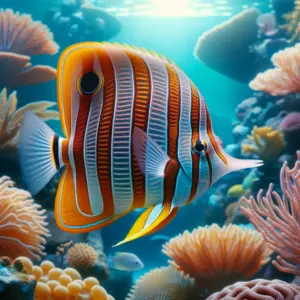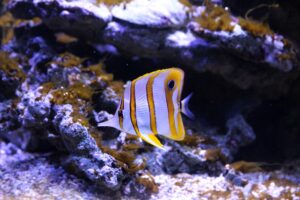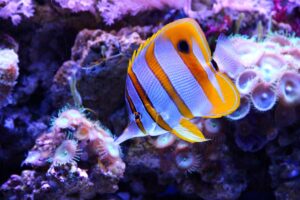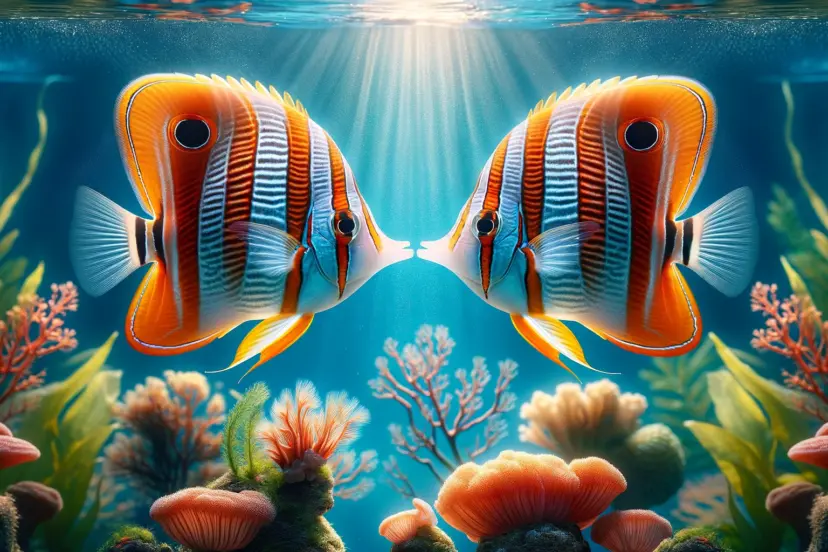Saltwater Butterfly Fish
Saltwater Butterfly Fish: An Enthusiast’s Guide
1. Introduction to Saltwater Butterfly Fish
1.1. What are Saltwater Butterfly Fish?
Saltwater butterfly fish, enchanting inhabitants of the marine world, are distinguished by their vibrant colors and distinct patterns. These fish belong to the family Chaetodontidae and are primarily found in the tropical and subtropical regions of the Indian, Pacific, and Atlantic Oceans. Renowned for their elegant swimming style and striking appearance, they are a centerpiece in many saltwater aquariums. Their unique shape, characterized by a compressed body and a continuous dorsal fin, makes them easily recognizable. Butterfly fish vary in size, but most species reach an average of 4 to 8 inches in adulthood.

1.2. Why They Captivate Aquarists
The allure of saltwater butterfly fish lies not just in their stunning visuals but also in their intriguing behaviors. Each species boasts a unique pattern and color scheme, making them a fascinating subject for marine enthusiasts. Their graceful movements and social nature add a dynamic element to any aquarium. Moreover, their interaction with the environment, such as feeding on coral polyps and invertebrates, provides insight into the complexity of marine ecosystems. However, their specific dietary and environmental needs pose a delightful challenge to aquarists, making them a prized possession for experienced hobbyists seeking to create a thriving, biodiverse marine habitat.
2. Choosing the Right Environment
2.1. Tank Requirements
Setting up the perfect home for saltwater butterfly fish is crucial for their well-being. These fish require a spacious tank to accommodate their active swimming habits, with a minimum capacity of 75 gallons being ideal for most species. The tank should include plenty of hiding places and live rock formations to mimic their natural reef habitat. This not only provides them with a sense of security but also encourages natural foraging behavior. Additionally, a well-functioning filtration system is essential to maintain clean and stable water conditions, crucial for the health of these sensitive fish.
2.2. Water Conditions
Maintaining optimal water conditions is paramount in caring for saltwater butterfly fish. The water temperature should be kept between 75°F and 82°F, with a pH level ranging from 8.1 to 8.4. Regular monitoring of ammonia, nitrite, and nitrate levels is necessary to ensure a healthy environment, as these fish are particularly sensitive to changes in water quality. Salinity should also be maintained at a specific gravity of 1.020 to 1.025. Frequent water changes, along with a stable and consistent environment, play a vital role in preventing stress and diseases in saltwater butterfly fish.

3. 10 Most Popular Types of Saltwater Butterfly Fish
3.1. Copperband Butterflyfish
The Copperband Butterflyfish, with its striking orange bands and elongated snout, is a popular choice for many aquarists. This species is known for its ability to control pest populations in the tank, such as aptasia. They require a varied diet of meaty foods and are known for their shy nature. Providing a peaceful environment with plenty of hiding spaces is key to keeping them healthy and stress-free.
3.2. Raccoon Butterflyfish
Raccoon Butterflyfish are cherished for their playful demeanor and distinct eye mask pattern. They are relatively hardy and adapt well to life in captivity. These fish thrive in a well-decorated tank that offers both open swimming space and hiding spots. A diet rich in marine algae and meaty foods suits them best. Their adaptability and charming personality make them a favorite among beginners and experienced aquarists alike.[…]
4. Companions for Your Butterfly Fish
4.1. Selecting Tank Mates
Choosing suitable tank mates for saltwater butterfly fish is essential for creating a harmonious aquarium. Ideal companions are non-aggressive, similar-sized fish that do not compete for food or territory. Suitable tank mates include clownfish, gobies, and certain species of tangs and wrasses. It’s important to avoid housing butterfly fish with larger, more aggressive species or those known to nip fins, as this can lead to stress and injury.
4.2. Compatibility Tips
Ensuring compatibility in your aquarium requires observation and understanding of each species’ behavior. Introducing new fish gradually and monitoring their interactions is crucial. Providing ample space and environmental enrichment, such as live rock formations and varied topography, can reduce territorial disputes and encourage peaceful cohabitation. Regular feeding and maintaining high water quality also play a significant role in minimizing aggression and stress among tank inhabitants.
5. Feeding Your Saltwater Butterfly Fish

5.1. Diet Essentials
A balanced diet is key to the health and vitality of saltwater butterfly fish. These fish are omnivores, requiring a mix of meaty foods and vegetable matter. High-quality marine flakes, pellets, and frozen foods like mysis shrimp and brine shrimp should form the basis of their diet. Supplementing with fresh, finely chopped seafood and algae helps mimic their natural feeding habits. Some species may also require live coral polyps or sponges as part of their diet, making them suitable only for advanced aquarists with well-established reef tanks.
5.2. Feeding Schedule
Consistency is crucial in feeding saltwater butterfly fish. They should be fed small amounts 2-3 times a day to mimic their natural grazing behavior. Overfeeding can lead to obesity and water quality issues, while underfeeding can cause stress and malnutrition. Observing your fish during feeding times helps gauge their dietary needs and preferences, allowing for adjustments as needed. Some species may be finicky eaters at first and require patience and experimentation with different food types to encourage feeding.
6. Health and Care
6.1. Common Health Issues
Saltwater butterfly fish are susceptible to various health issues, particularly if water quality is not meticulously maintained. Common ailments include bacterial infections, parasitic infestations like ich, and nutritional deficiencies. Recognizing early signs of distress, such as changes in swimming behavior, appetite, or appearance, is critical for prompt intervention. Quarantining new arrivals and regular observation of all fish play a crucial role in early detection and treatment of health issues.
6.2. Preventative Care
Preventative care is the best approach to maintaining the health of saltwater butterfly fish. This includes regular water testing and changes, maintaining stable water parameters, and providing a varied, nutritionally complete diet. Avoid overcrowding and carefully select compatible tank mates to reduce stress. Regular inspection of the fish and immediate action if any signs of illness are observed can prevent the spread of diseases within the tank.
7. Breeding Saltwater Butterfly Fish

7.1. Breeding Conditions
Breeding saltwater butterfly fish in captivity is a challenging yet rewarding endeavor. Success largely depends on replicating their natural habitat and conditions. A separate breeding tank with controlled water parameters and a peaceful environment increases the likelihood of breeding. Providing a diet rich in high-quality, nutritious foods can also encourage breeding behavior. However, breeding success varies greatly among different butterfly fish species, with some being more difficult to breed than others.
7.2. Rearing Young Fish
Rearing young saltwater butterfly fish requires special care and attention. The larvae are typically small and vulnerable, needing a diet of microscopic plankton or specially formulated feeds. Maintaining pristine water conditions is crucial for their survival. As they grow, gradually introducing them to the same diet as adult fish is important. The process requires patience, as it can take several months for the young fish to mature and acclimate to the general aquarium environment.
8. Challenges and Solutions
8.1. Overcoming Common Problems
One of the biggest challenges in keeping saltwater butterfly fish is meeting their specific dietary needs. Some species require live coral or specific types of algae, making their care complex. Ensuring compatibility with tank mates and preventing aggressive behavior is another common challenge. To overcome these issues, thorough research on each species’ needs, vigilant monitoring of tank dynamics, and a willingness to make adjustments are essential. Seeking advice from experienced aquarists and professionals can also provide practical solutions and help navigate these challenges.
8.2. Expert Advice
Leveraging expert advice is invaluable in caring for saltwater butterfly fish. Joining online forums, consulting with local aquarium clubs, and seeking guidance from professional aquarists can provide insights and tips based on real-life experiences. Additionally, staying informed about the latest research and advancements in marine biology and aquarium care can greatly enhance your ability to provide the best possible environment for your butterfly fish.
9. Innovations in Butterfly Fish Care

9.1. Latest Trends and Technologies
The field of marine aquarium keeping is continually evolving, with new technologies and practices emerging regularly. Automated feeding systems, advanced filtration methods, and LED lighting that mimics natural light cycles are some of the innovations enhancing the care of saltwater butterfly fish. These advancements not only simplify maintenance but also create more naturalistic and healthier environments for the fish.
9.2. Future Prospects
The future of saltwater butterfly fish care looks promising, with ongoing research into their breeding, diet, and habitat requirements. Efforts to breed more species in captivity are expected to reduce the pressure on wild populations, contributing to conservation efforts. Technological advancements in aquarium equipment and a deeper understanding of marine biology are poised to further improve the care and well-being of these stunning creatures.
10. Conclusion
Caring for saltwater butterfly fish is a fulfilling hobby that requires dedication, knowledge, and a love for marine life. Understanding their specific needs, from diet to tank environment, is key to ensuring their health and happiness. While challenges exist, the rewards of watching these beautiful fish thrive in a well-maintained aquarium are immeasurable. Whether you’re a seasoned aquarist or just starting, the journey with saltwater butterfly fish is always full of learning and wonder.

FAQs
1. What is the ideal tank size for saltwater butterfly fish?
The ideal tank size varies depending on the species, but a minimum of 75 gallons is recommended for most saltwater butterfly fish. This provides enough space for swimming and territories.
2. Can saltwater butterfly fish be kept with other species?
Yes, they can be kept with other non-aggressive, similar-sized fish. It’s important to choose tank mates that do not compete for food or territory to avoid stress.
3. What do saltwater butterfly fish eat?
They require a varied diet of meaty foods and vegetables. High-quality marine flakes, pellets, and frozen foods like mysis shrimp and brine shrimp are ideal, along with fresh seafood and algae.
4. How do you breed saltwater butterfly fish in captivity?
Breeding them involves replicating their natural habitat, providing a peaceful environment, and a nutritionally rich diet. However, breeding success varies among species.
5. What are some common health issues in saltwater butterfly fish?
Common issues include bacterial infections, parasitic infestations like ich, and nutritional deficiencies. Regular tank maintenance and observation are key to preventing these issues.




